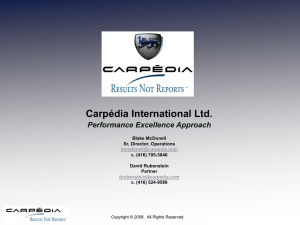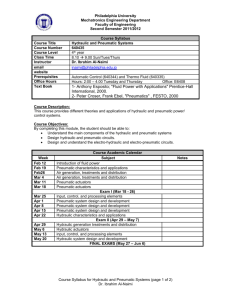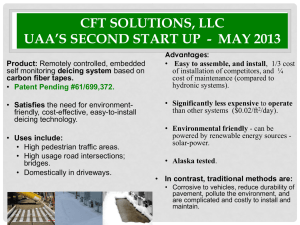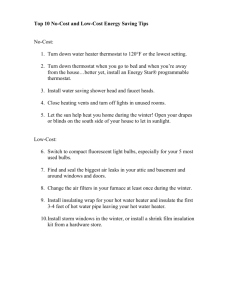HG088-003.2-3_Food_ Beverage Manufacturing
advertisement
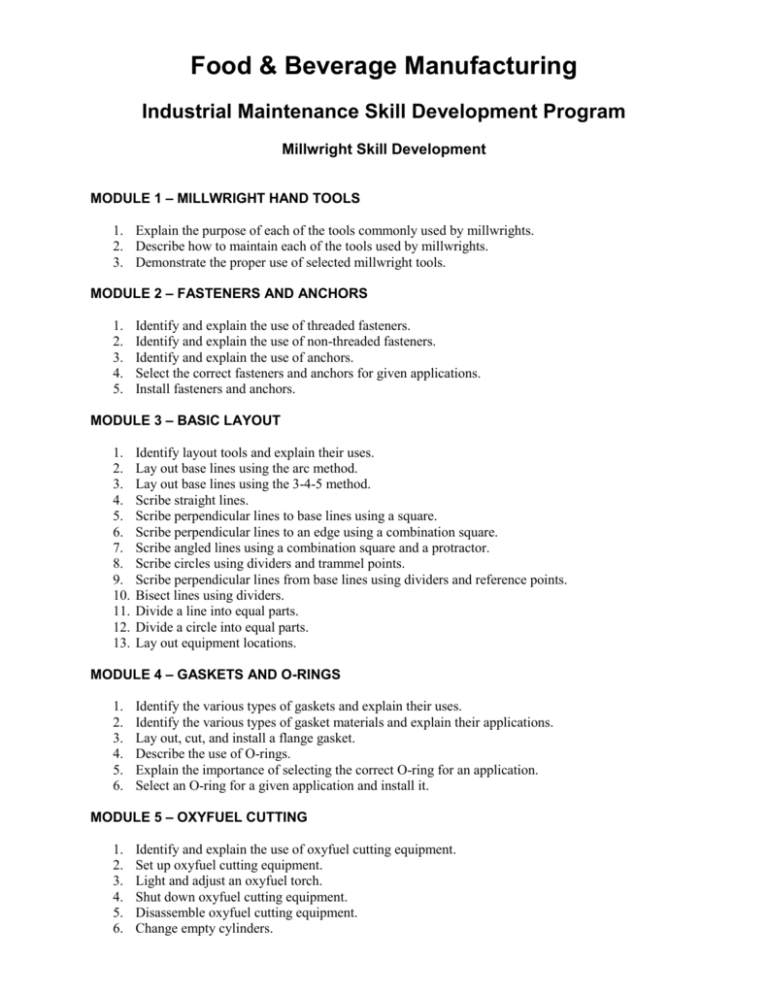
Food & Beverage Manufacturing Industrial Maintenance Skill Development Program Millwright Skill Development MODULE 1 – MILLWRIGHT HAND TOOLS 1. Explain the purpose of each of the tools commonly used by millwrights. 2. Describe how to maintain each of the tools used by millwrights. 3. Demonstrate the proper use of selected millwright tools. MODULE 2 – FASTENERS AND ANCHORS 1. 2. 3. 4. 5. Identify and explain the use of threaded fasteners. Identify and explain the use of non-threaded fasteners. Identify and explain the use of anchors. Select the correct fasteners and anchors for given applications. Install fasteners and anchors. MODULE 3 – BASIC LAYOUT 1. 2. 3. 4. 5. 6. 7. 8. 9. 10. 11. 12. 13. Identify layout tools and explain their uses. Lay out base lines using the arc method. Lay out base lines using the 3-4-5 method. Scribe straight lines. Scribe perpendicular lines to base lines using a square. Scribe perpendicular lines to an edge using a combination square. Scribe angled lines using a combination square and a protractor. Scribe circles using dividers and trammel points. Scribe perpendicular lines from base lines using dividers and reference points. Bisect lines using dividers. Divide a line into equal parts. Divide a circle into equal parts. Lay out equipment locations. MODULE 4 – GASKETS AND O-RINGS 1. 2. 3. 4. 5. 6. Identify the various types of gaskets and explain their uses. Identify the various types of gasket materials and explain their applications. Lay out, cut, and install a flange gasket. Describe the use of O-rings. Explain the importance of selecting the correct O-ring for an application. Select an O-ring for a given application and install it. MODULE 5 – OXYFUEL CUTTING 1. 2. 3. 4. 5. 6. Identify and explain the use of oxyfuel cutting equipment. Set up oxyfuel cutting equipment. Light and adjust an oxyfuel torch. Shut down oxyfuel cutting equipment. Disassemble oxyfuel cutting equipment. Change empty cylinders. 7. Perform oxyfuel cutting: Straight line and square shapes Bevels Piercing and slot cutting Washing 8. Operate a motorized, portable oxyfuel gas cutting machine. MODULE 6 - INTERMEDIATE TRADE MATH 1. 2. 3. 4. 5. 6. 7. Use ratios and proportions. Solve basic algebra problems. Solve area problems. Solve volume problems. Solve circumference problems. Solve circular speed problems. Use tables. MODULE 7 - FIELD SKETCHING 1. 2. 3. 4. 5. 6. 7. Sketch straight lines. Sketch angles. Sketch arcs and circles. Sketch ellipses. Sketch dimensions. Make orthographic sketches. Make pictorial sketches. MODULE 8 - INTERMEDIATE BLUEPRINT READING 1. Explain orthographic projection. 2. Interpret schematic drawings. 3. Interpret isometric drawings. MODULE 9 - SPECIALTY TOOLS 1. 2. 3. 4. 5. 6. 7. 8. 9. 10. 11. 12. 13. Use torque multipliers. Use cable cutters. Use nut splitters. Use keyseat rules. Use depth gauges. Use bevels. Use telescoping gauges. Use radius gauges. Use drill gauges. Use thickness gauge stock. Use a plasti-gauge. Explain hardness testers. Explain surface roughness testers. MODULE 10 - MILLWRIGHT POWER TOOLS 1. 2. 3. 4. 5. 6. Explain power tool safety. Use and care for drill presses. Use and care for hydraulic presses. Use and care for pipe threading machines. Use and care for nibblers. Use and care for bandsaws. 7. 8. 9. 10. 11. 12. Identify and explain belt sanders. Identify and explain Woodruff key seaters. Identify and explain key broaches. Use and care for bearing heaters. Use and care for drills. Perform precision drilling. MODULE 11 – RIGGING 1. Identify and describe the uses of common rigging hardware and equipment. 2. Inspect common rigging equipment. 3. Select, use, and maintain special rigging equipment, including: Chain hoists Come-alongs Jacks Tugger 4. 5. 6. 7. Tie knots used in rigging. Use and understand the correct hand signals to guide a crane operator. Identify basic rigging and crane safety procedures. Explain load balancing. MODULE 12 - SETTING BASEPLATES AND SOLEPLATES 1. Establish baseplate and soleplate locations. 2. Install baseplates and soleplates. 3. Field-verify a plate installation. MODULE 13 – LUBRICATION 1. 2. 3. 4. 5. 6. 7. 8. 9. 10. 11. 12. 13. Explain OSHA hazard communication as pertaining to lubrication. Read and interpret a material safety data sheet (MSDS). Explain the EPA hazardous waste control program. Explain lubricant storage. Explain lubricant classification. Explain lubricant film protection. Explain properties of lubricants. Explain properties of greases. Explain how to select lubricants. Identify and explain types of additives. Identify and explain types of lubricating oils. Identify and use lubrication equipment to apply lubricants. Read and interpret a lubrication chart. MODULE 14 - INTRODUCTION TO BEARINGS 1. 2. 3. 4. Identify various types of bearings. Identify and explain bearing materials. Identify parts of bearings. Explain bearing designation numbers per manufacturer’s specifications. MODULE 15 - ADVANCED TRADE MATH 1. 2. 3. 4. Use tables of equivalents. Use unit conversion tables. Perform right angle trigonometry. Calculate weights of objects. MODULE 16 - PRECISION MEASURING TOOLS 1. 2. 3. 4. 5. 6. 7. 8. Use levels. Use calipers. Use micrometers. Use dial indicators. Use universal bevel protractors. Use gauge blocks. Use speed measurement tools. Use pyrometers. MODULE 17 - INSTALLING PACKING 1. 2. 3. 4. Identify and explain the types of packing. Identify and explain packing materials. Remove packing. Install packing. MODULE 18 - INSTALLING SEALS 1. Identify and explain types of seals. 2. Identify and explain seal materials. 3. Remove and install seals. MODULE 19 - INSTALLING MECHANICAL SEALS 1. Identify and explain types of mechanical seals. 2. Explain mechanical seal classification. 3. Remove, inspect, and install mechanical seals. MODULE 20 - REMOVING AND INSTALLING BEARINGS 1. Identify common bearing failure modes and describe the conditions that cause them. 2. Describe the safety precautions that must be followed and the personal protective equipment that must be worn when removing and installing bearings. 3. Remove defective bearings using manual pullers and/or a press. 4. Describe using heat to remove a defective bearing. 5. Install new bearings by heating the bearing or applying pressure. 6. Install pillow block bearings. MODULE 21 – COUPLINGS 1. Identify and explain coupling types. 2. Install couplings. 3. Remove couplings. MODULE 22 - FABRICATING SHIMS 1. Identify and explain types of shim stock. 2. Identify and explain shim materials. 3. Fabricate shims. MODULE 23 - ALIGNMENT FIXTURES AND SPECIALTY JIGS 1. Identify and explain types of jigs. 2. Fabricate jigs. 3. Set up jigs. MODULE 24 - PREALIGNMENT FOR EQUIPMENT INSTALLATION 1. 2. 3. 4. Inspect equipment. Install couplings. Set STAT equipment. Set MTBM equipment. MODULE 25 - INSTALLING BELT AND CHAIN DRIVES 1. 2. 3. 4. Identify and explain belt drive types. Install belt drives. Identify and explain chain drive types. Install chain drives. MODULE 26 - INSTALLING FANS AND BLOWERS 1. 2. 3. 4. Identify and explain types of fans. Explain how to install fans. Identify and explain types of blowers. Explain how to install blowers. MODULE 27 – CONVEYORS 1. 2. 3. 4. 5. 6. Explain conveyor safety. Identify and explain the use of roller conveyors and their components. Identify and explain the use of belt conveyors and their components. Identify and explain the use of chain conveyors and their components. Identify and explain the use of screw conveyors and their components. Identify and explain the use of pneumatic conveyors and their components. MODULE 28 - TROUBLESHOOTING AND REPAIRING CONVEYORS 1. 2. 3. 4. Maintain, troubleshoot, and repair belt and roller conveyors. Maintain, troubleshoot, and repair chain conveyors. Maintain, troubleshoot, and repair screw conveyors. Maintain, troubleshoot, and repair pneumatic conveyors. MODULE 29 - CONVENTIONAL ALIGNMENT 1. 2. 3. 4. Explain types of misalignment. Align couplings, using the straightedge and feeler gauge method. Identify and eliminate coupling stress. Align couplings, using the dial indicator method. MODULE 30 – PUMPS 1. 2. 3. 4. Identify and explain centrifugal pumps. Identify and explain rotary pumps. Identify and explain reciprocating pumps. Identify and explain metering pumps. 5. Identify and explain vacuum pumps. 6. Explain net positive suction head and cavitation. 7. Install pumps. MODULE 31 - TROUBLESHOOTING AND REPAIRING PUMPS 1. 2. 3. 4. 5. 6. 7. 8. Inspect a pump. Troubleshoot a pump. Prepare a pump for shutdown and repair. Remove a pump from the system. Disassemble a pump. Reassemble a pump. Install a pump. Use a checklist for pump startup. MODULE 32 - COMPRESSORS AND COMPRESSOR MAINTENANCE 1. 2. 3. 4. 5. Explain pneumatic safety. Explain the principles of compressor operation. Identify and explain types of compressors. Troubleshoot compressors. Replace compressor components. MODULE 33 - BASIC PNEUMATIC SYSTEMS 1. Explain compressed air treatment. 2. Identify and explain pneumatic system components and symbols. MODULE 34 - TROUBLESHOOTING AND REPAIRING PNEUMATIC SYSTEMS 1. 2. 3. 4. 5. Perform pneumatic system preventive maintenance procedures. Inspect pneumatic system components. Read pneumatic system schematic diagrams. Troubleshoot pneumatic systems. Repair pneumatic system components. MODULE 35 - BASIC HYDRAULIC PUMPS 1. 2. 3. 4. 5. 6. Explain hydraulic system safety. Explain the principles of hydraulics. Identify and explain hydraulic fluids. Identify and explain hydraulic system parts. Identify and explain hydraulic pumps. Identify and explain hydraulic motors. MODULE 36 - TROUBLESHOOTING AND REPAIRING HYDRAULIC EQUIPMENT 1. 2. 3. 4. 5. Inspect hydraulic system equipment. Read hydraulic system schematic diagrams. Explain the basic hydraulic principles that must be considered before troubleshooting. Troubleshoot hydraulic systems. Repair or replace hydraulic system components. MODULE 37 - TROUBLESHOOTING AND REPAIRING GEARBOXES 1. 2. 3. 4. 5. 6. 7. 8. Identify and explain gearboxes. Explain how gears operate and identify types of gears. Identify types of gearboxes. Troubleshoot gearboxes. Remove and disassemble gearboxes. Identify gear wear patterns. Measure and adjust backlash and bearing clearance. Install and maintain gearboxes. MODULE 38 - REVERSE ALIGNMENT 1. 2. 3. 4. 5. 6. 7. Explain how machinery can be misaligned. Explain the conditions that can cause misalignment. Measure shaft and coupling runout, using a dial indicator. Set up complex reverse dial indicator jigs. Measure indicator sag using complex reverse dial indicator jigs. Perform reverse dial indicator alignment, using a graphical alignment chart. Perform reverse dial indicator alignment, using the mathematical equation. MODULE 39 - LASER ALIGNMENT 1. 2. 3. 4. Explain lasers and laser alignment systems. Operate a laser alignment system. Explain soft foot, thermal growth, and coupling stress. Troubleshoot repeatability and laser problems. MODULE 40 - ADVANCED BLUEPRINT READING 1. 2. 3. 4. 5. 6. 7. 8. Explain the use of a drawing numbering system. Identify the types of drawings in a drawing package. Read and interpret plant or foundation layout drawings. Read and interpret assembly drawings. Read and interpret detail drawings. Identify and explain the parts of a machine drawing. Locate individual components on a plant layout. Locate an assembly drawing using a detail part. MODULE 41 - OPTICAL ALIGNMENT 1. Explain how to use a theodolite, a precision tilting level, a total station, and an auto level. 2. Level equipment using optical alignment. MODULE 42 - INSTALLING ELECTRIC MOTORS 1. Explain proper methods for motor storage. 2. Explain proper rigging and handling of motors. 3. Determine if a motor has a thrust bearing or relies on electromagnetic force to determine rotor location. 4. Properly align the motor to the specified equipment. 5. Verify rotation and coupling gap. MODULE 43 - PREVENTIVE AND PREDICTIVE MAINTENANCE 1. 2. 3. 4. 5. 6. Explain preventive and predictive maintenance. Explain nondestructive testing. Explain visual and optical inspection. Explain liquid penetrant inspection. Explain magnetic particle inspection. Explain infrared testing. MODULE 44 - VIBRATION ANALYSIS 1. 2. 3. 4. 5. List four causes of vibration. Identify characteristics of a vibration cycle. Identify and explain the different kinds of basic vibration test equipment. Explain vibration monitoring. Explain field balancing of machines. This workforce solution was funded by a grant awarded under the President’s High Growth Job Training Initiative as implemented by the U.S. Department of Labor’s Employment and Training Administration. The solution was created by the grantee and does not necessarily reflect the official position of the U.S. Department of Labor. The Department of Labor makes no guarantees, warranties, or assurances of any kind, express or implied, with respect to such information, including any information on linked sites and including, but not limited to, accuracy of the information or its completeness, timeliness, usefulness, adequacy, continued availability, or ownership. This solution is copyrighted by the institution that created it. Internal use by an organization and/or personal use by an individual for non-commercial purposes is permissible. All other uses require the prior authorization of the copyright owner.
